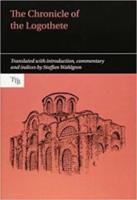
Liverpool UP (2019) h/b 298pp. £85.00 (ISBN 9781786942074)
The Chronicle of Manasses has already been reviewed here and that of The Logothete (his real name is obscure) is of the same genre, that is, a potted world history from dot to the last emperor the writer experienced (AD 948). The number of such chronicles suggests their popularity with the Byzantine readership, but whilst some exist in only one manuscript, there are thirty of The Logothete’s along with other associated manuscripts, and evidence of its having been translated into Old Slavonic at least twice. Was The Logothete a star amongst chroniclers?
The intention of a chronicle was to show how the dynasties of Byzantine rulers form the logical end of history, from Genesis, through the Old Testament, thence to Mesopotamian, Greek and Roman history, ending with the suzerainty of Byzantium. The position of the emperors is justified by all previous history, and that previous history is made sense of by the holy dynasties. So it should not be so surprising that republican Rome doesn’t get a look in, but what about the absence of dedicated New Testament history? In the Holy Empire, that, surely, is taken for granted.
As in Manasses, the author adds his own flavour to creation: ‘When the earth had shed the waters lying on it, it was ordered to bring forth plants and seeds of different kinds, and it produced fruit-bearing trees … countless kinds of shoots and plants … cornfields … cedars and cypresses …’. We also see, as is not the case with Manasses, reference to current Byzantine thinking, physical and metaphysical, to justify and enhance the creation text: ‘Water came into being at the same time as earth, and so did fire. And a clear proof of this is that abundant fire comes forth from stone and iron …’. Or ‘… the soul of irrational animals is of earth … When blood coagulates, it becomes flesh, and when flesh decays, it is dissolved into earth’. At times the Logothete comments on the text like a modern concordance, as when he feels the need to explain that when God created light, this was the light that shined on the earth. Clearly there had always been light above the earth, otherwise the choirs of angels would have been in the dark, which would be unthinkable. Subsequent history relies more on plain narrative, and seems to need less explanation.
The importance of this chronicle cannot be overstressed: for us it is the most important Byzantine history for the hundred years after Theophanes, who covered up to the early ninth century. It is a great historical and historiographical read, too. For the Byzantines, it was a rhetorical piece designed to show why they were what they were—as destined by history from the time of Adam (albeit in a much reduced empire). It reminds me of a poster in my Sunday School room in the early fifties, showing Jesus holding the hand of a Boy Scout, pointing to a very pink map of the world.
Adrian Spooner
